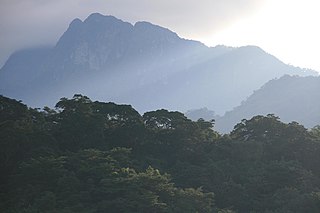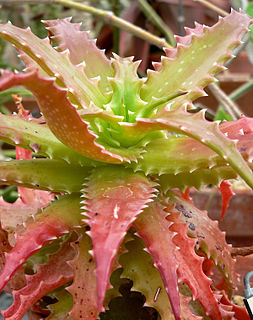The Rubeho akalat is a member of the Old World flycatcher family, (Muscicapiidae), known from the Eastern Arc of Tanzania. Akalats trapped in 1989 here were assumed to be an isolated population of Iringa akalat which occurs c. 150 km to the south, but further specimens collected in 2000 led to the description of the bird as a new species. The bird's English name relates to its type locality, Rubeho Mountains, Morogoro; the scientific name to the ochraceous colour on its throat and upper breast.
The Nguru Mountains are a mountain range in Morogoro Region, Tanzania, Africa. The Nguru Mountains are part of the Eastern Arc Mountains. The mountains are predominantly covered with rainforest, home to 83 species of birds and African violets. There are a number of forest reserves in the mountains.

The Udzungwa Mountains are a mountain range in south-central Tanzania. The mountains are mostly within Iringa Region, south of Tanzania's capital Dodoma. The Udzungwa Mountains are part of the Eastern Arc Mountains, and are home to a biodiverse community of flora and fauna with large numbers of endemic species.

The Usambara Mountains of northeastern Tanzania in tropical East Africa, comprise the easternmost ranges of the Eastern Arc Mountains. The ranges of approximately 90 kilometres (56 mi) long and about half that wide, are situated in the Lushoto District of the Tanga Region. They were formed nearly two million years ago by faulting and uplifting, and are composed of Precambrian metamorphic rocks. They are split into two sub-ranges; the West Usambaras being higher than the East Usambaras, which are nearer the coast and receive more rainfall.

The servaline genet is a genet species native to Central Africa. As it is widely distributed and considered common, it is listed as Least Concern on the IUCN Red List.

The black and rufous elephant shrew, the black and rufous sengi, or the Zanj elephant shrew is one of the 17 species of elephant shrew found only in Africa. It is native to the lowland montane and dense forests of Kenya and Tanzania. Like other members of the genus Rhynchocyon, it is a relatively large species, with adults averaging about 28 cm (11 in) in length and 450-700 g (1.0-1.5 lb) in weight.
Newtonia erlangeri is a species of legume in the family Fabaceae. It is found in Kenya, Somalia, and Tanzania.
Zenkerella egregia is a species of plant in the family Fabaceae. It is found only in Tanzania.
Zenkerella is a genus of plants in the family Fabaceae.
Anonidium usambarense was a tall tree in the family Annonaceae, formerly endemic to Tanzania. A single specimen was collected in 1910 at Amani in the Usambara mountains, at an altitude of 900m. In spite of intensive field work in the region looking specifically for this species, no other examples were found and it was declared extinct in 1998. The causes for its disappearance were the timber industry and the desire to expand agricultural land.
Isolona heinsenii is a species of plant in the Annonaceae family. It is endemic to Tanzania.
Lettowianthus is a genus of plant in family Annonaceae. It contains a single species, Lettowianthus stellatus, which is found in Kenya and Tanzania.
Abisara delicata, the delicate Judy is a butterfly in the family Riodinidae. It is found in Tanzania and Malawi.
Callulina shengena is a species of frogs in the family Brevicipitidae. It was discovered in 2010 during a survey of rainforests in the northern part of the Eastern Arc Mountains of Tanzania. It is present at two locations in Chome Forest Reserve at altitudes between 1,920 and 2,100 m. The forests in which it lives are being selectively felled, and the International Union for Conservation of Nature has rated its conservation status as "critically endangered".
Callulina stanleyi is a species of frogs in the family Brevicipitidae. It was discovered in 2010 during a survey of rainforests in the northern part of the Eastern Arc Mountains of Tanzania. It was named in honour of the American zoologist, William T. Stanley, of the Field Museum, Chicago, who has done much research into the amphibians of Tanzania. It is present at three locations along the eastern border of Chome Forest Reserve at altitudes between 1,100 and 1,300 m. It is rated as "critically endangered" by the International Union for Conservation of Nature.

Aloe dorotheae is a critically endangered succulent plant in the family Asphodelaceae. It is native to Tanzania.

The Ukaguru Mountains are a mountain range in central Tanzania. The mountains are in Morogoro region, east of Tanzania's capital Dodoma. The mountains are named for the Kaguru people. The Ukaguru Mountains are part of the Eastern Arc Mountains, and are home to a biodiverse community of flora and fauna with large numbers of endemic species.
The Nguu Mountains are a mountain range in Tanga Region of Tanzania. The Nguu Mountains are part of the Eastern Arc Mountains. The mountains are covered in woodland, grassland, and forest.
Malundwe Mountain, also known as Malundwe Hill, is a mountain in Tanzania. It is located in Mikumi National Park in Morogoro Region.






